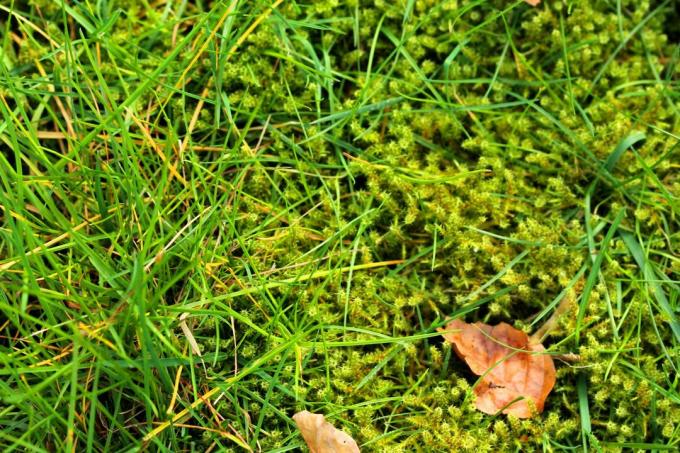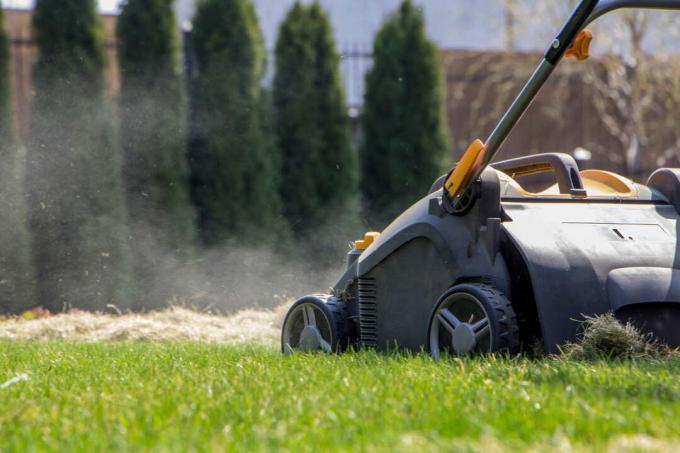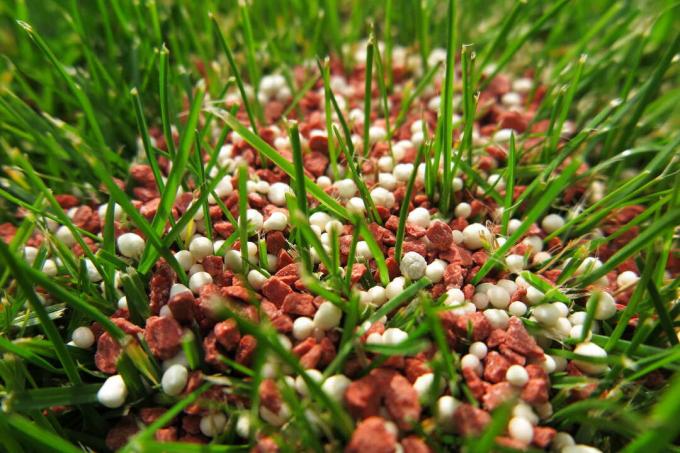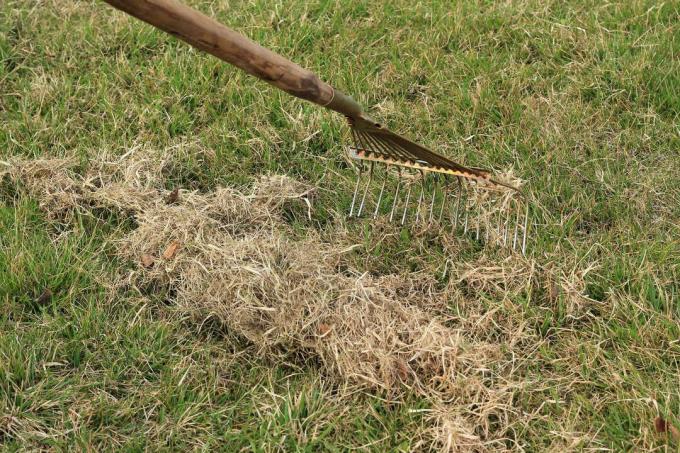Moss offers a soft surface for walking barefoot, but it is rather undesirable in the lawn. We show you how to successfully remove moss from your lawn.
Moss in the lawn feels nice when you walk over it barefoot, but it does cause some problems for the lawn. Moss develops in light sward when the lawn does not find ideal growth conditions. Once there is a nice layer of moss on the lawn, the soil conditions for the lawn become increasingly worse. The air and water permeability of the soil is reduced and the grass roots are less supplied with the vital elements air and water.
contents
- Moss in the lawn: the causes
-
Moss in the lawn: prevent and avoid
- Selection of lawn seeds
- Proper lawn care and lawn fertilization
-
Moss in the lawn: remove and control successfully
- 1. Moss in the lawn: scarify and ventilate
- 2. Lime against moss in the lawn
- 3. Moss in the lawn: fertilize properly
- 4. Fertilizing with compost
- 5. Regularly sand heavy soils against moss
- 6. Moss in the lawn: mowing properly
- 7. Moss destroyer against moss in the lawn
Moss in the lawn: the causes
Mosses always spread when grasses are dormant (i.e. from autumn to spring) or are weakened. Poor growth conditions for lawns, such as shade, compaction, lack of nutrients or poor soil permeability, offer mosses a growth advantage. Moss is not in itself an intrusive enemy, but the symptom of neglected lawn. The promotion of lawn growth and the ideal soil conditions for it is accordingly the best method for preventing and controlling moss.

The most common causes of moss formation:
- Rainy weather periods
- Waterlogging
- Insufficient nutrient supply in the soil
- Acid soils (pH below 5)
- Compacted soils
- Shady locations
In very few cases it is only one of these factors that favor the formation of moss. Often several of the causes mentioned work together and create conditions that are unfavorable for grasses and beneficial for mosses.
Moss in the lawn: prevent and avoid
True to the motto “prevention is better than cure”, it is easier to take preventive measures against moss than to fight a strong infestation.
Selection of lawn seeds
The fact that mosses are often found in shady, compacted or very loamy locations is often due to the competitive strength, which most grasses lack under these circumstances. You do not feel comfortable there and are weakened. The faster it comes to gaps in the sward, which the moss then fills in. Types of grass specially adapted to shady or wet meadows are more competitive and ensure that moss does not penetrate as quickly or not at all. For this reason, use seed mixtures when planting the lawn that are, for example, specially made for Shadow lawn are suitable like ours Plantura shadow lawn. For example the bluegrass (Poa supina) also grows wonderfully and competitively in shady locations.
Even with very heavy soils, it is worth looking for suitable grasses. Before every new lawn is laid, the soil should also be prepared well, for example with drainage in the case of heavy soils. This helps to prevent weed infestation as well as moss.
Proper lawn care and lawn fertilization
Will the Lawn properly cared for and fertilized, an excessive spread of moss can be prevented. This also includes regular mowing, because when the grass is tall, the surface of the ground does not dry as well and thus favors the moss. Regular care is also part of good care Fertilizing the lawn, for example with our Plantura organic lawn fertilizer. It strengthens the grass and prevents patchy sward.
Moss in the lawn: remove and control successfully
If the lawn already has soft moss fluff, there are several ways to remove it:
1. Moss in the lawn: scarify and ventilate
The most important mechanical measure against moss is that Scarifying the lawn. The ground is scratched a few centimeters deep, removing the moss and the felt. The grass roots take minimal damage. After scarifying the moss from the grass, it is then scarified a second time in the event of heavy moss infestation. After scarifying, the seeds are re-sown and fertilized at the same time. When re-sowing, use seeds that are specially adapted to the location in order to prevent renewed moss infestation.

2. Lime against moss in the lawn
Acid soil alone does not cause moss infestation. The low pH value is often the result of impermeable soil. In any case, under acidic conditions, grasses do worse than moss, which can therefore spread undisturbed under acidic conditions. Before using lime as a remedy for moss, you should definitely test the pH of your soil. If this is below 5, you can limescale. After liming, the pH should be at best 6 - 6.5, at most 7. If the pH value of your soil changes drastically as a result of the liming, for example if the pH value has risen from 4 to 6.5, the moss infestation may disappear completely for a short time. Moss is very sensitive to changes in pH.
Caution: However, the disappearance of the moss must not induce you to limescale again the next time the moss infestation occurs. This could result in the pH being too high for the grasses at some point. Before every liming, the pH value should be tested first.
3. Moss in the lawn: fertilize properly
Lawn likes nutrient-rich soil - moss, on the other hand, gets along well with poor soil. In order to strengthen the lawn grasses, they are regularly supplied with nutrients in the form of fertilizers. Since moss infestation is favored above all in the cold season and in the late winter, it is best to prevent it with a potassium-accentuated one Autumn fertilization before.

4. Fertilizing with compost
For heavy and wet soils, fertilizing with compost can help improve the soil structure. Compost can either be mixed with sand and worked into the lawn using a rake or a few weeks after sanding. The addition of compost fertilizer in the course of reseeding is also highly recommended. One to five liters of fine compost per square meter are worked into the existing lawn with a rake. The compost then covers the soil surface or the sown lawn seeds no more than one cm. At best, it rains shortly after the compost has been added.
5. Regularly sand heavy soils against moss
In order to improve the air and water permeability of the soil and thus create ideal growth conditions for grasses, heavy soils are sanded once or twice a year. So lawn sand is a typical method of combating the causes of moss. For slightly sandy soils, sprinkle 3 l of sand / m2. For very loamy soils 5 l / m2. The grain size of the sand should be between 0.06 and 2 mm.
6. Moss in the lawn: mowing properly
Even if it is annoying, the rule applies: Frequently Cut the lawn with little loss of mass it is better tolerated by the lawn and maintains its competitive strength against moss and weeds. The more often it is mowed, the denser the sward and the more difficult it is for moss to nestle between the grasses. In order to make the lawn strong against moss, it has been proven to mow only a third to a maximum of half the length of the lawn. Utility lawn that should be cut to four and a half to six cm is mowed with a length of seven and a half to a maximum of eleven cm.
By the way: Ornamental lawns are mowed more frequently and for a shorter period of time, shaded lawns less deep.
7. Moss destroyer against moss in the lawn
If the mechanical removal of the moss with the scarifying device is unsuccessful, a so-called moss destroyer can be used in an emergency. Compared to weed killers, iron (II) sulfate is a relatively environmentally friendly active ingredient that causes the moss to die off. Before treatment, the lawn is mowed to a depth of four cm. Iron (II) sulfate causes the moss to die off within about two weeks. The lawn is then scarified and faired to remove the dead moss. Most of the time, after scarifying, it is re-sown to close bald spots in the lawn. After using moss killers, it is better to wait a few weeks, as these agents can have a germ-inhibiting effect.

Correct watering is an important step in caring for lawns. When and how to The lawn is watered properly, learn from this article.


